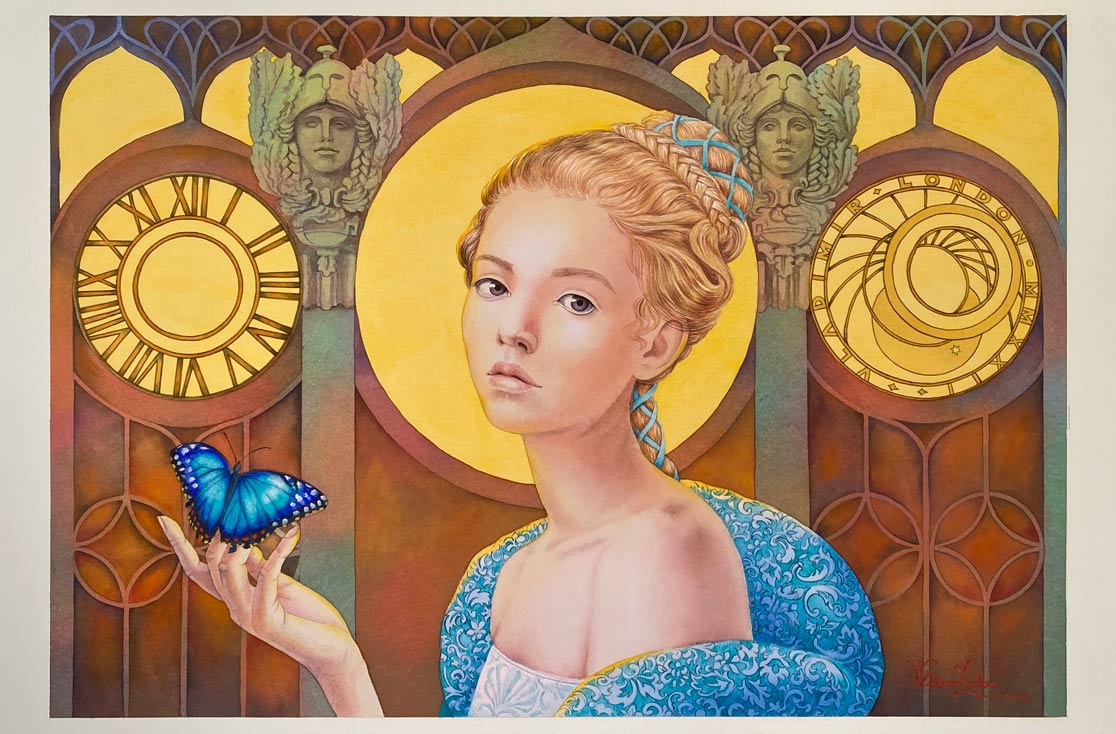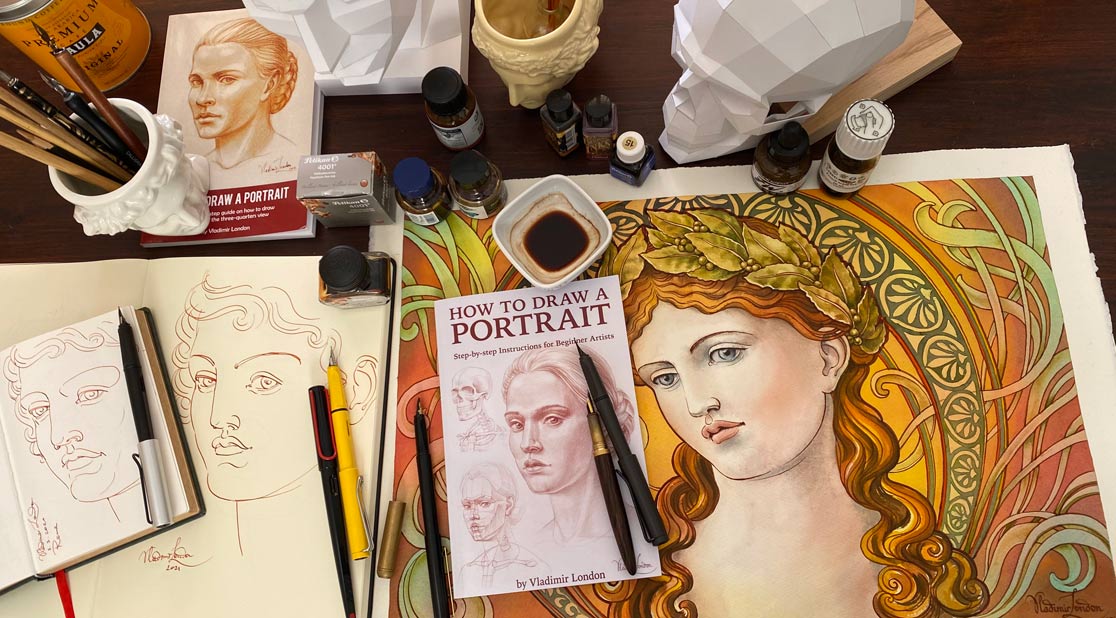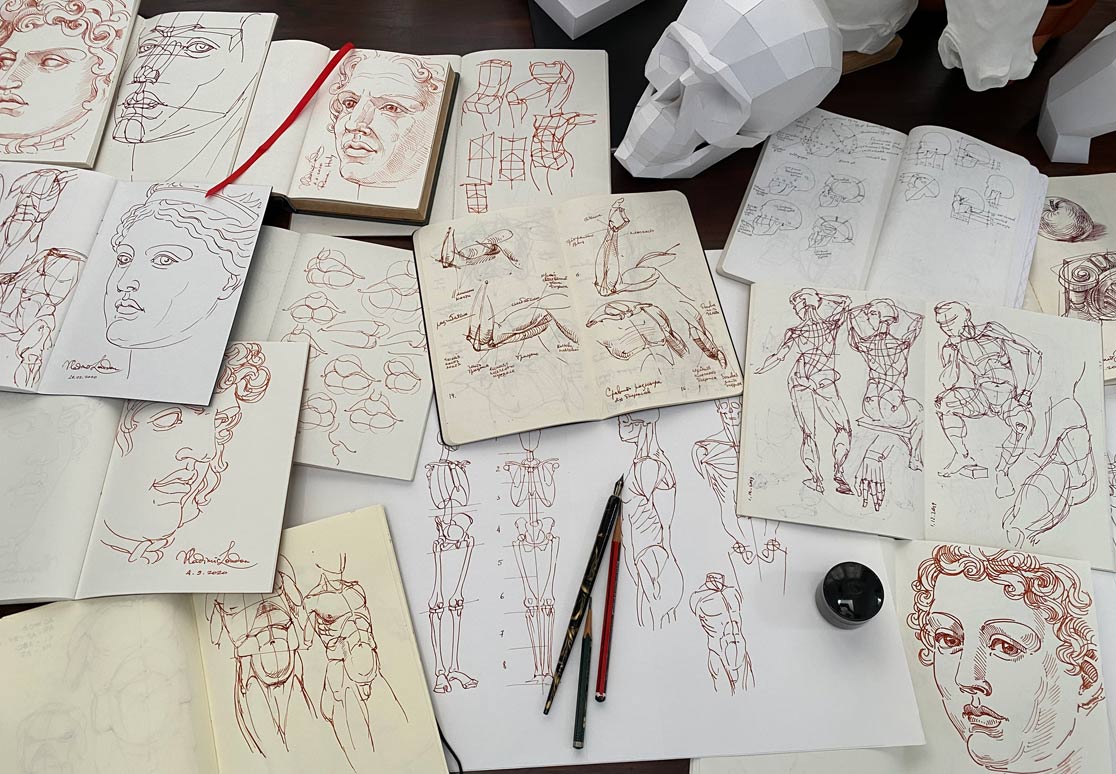How to Learn Drawing and Painting the right way
We received the following message from Dan, who asked how to learn good drawing and painting skills:
"I have no art training at all. I'd like to progress to watercolor as well as drawing. Where is the best place to start? Anatomy perhaps? I've no clue about any of this. I'd like to have a solid foundation and then build for the future. What do you advise?"
Reply from Vladimir London, art tutor
Watercolor by Vladimir London
Dear Dan,
Thank you for your questions on how to learn drawing and watercolor.
Ideally, to get a good foundation in fine art, you need a proper art school that teaches six subjects simultaneously from complete basics to the advanced level. Such subjects include drawing, painting, sculpting, composition, applied arts and history of arts. The reason why you need all of those subjects is because without good art education, your skills will be limited. Without solid drawing skills, your every painting will look naïve. Without sculpting, you will lack three-dimensional understanding of objects and this will limit your constructive drawing skills. Without composition, you will face challenges of composing artworks to tell the story you have in mind. And without applied arts, your skills will be limited to a narrow niche of media. In addition, you need to develop a good taste in art, which only comes with a solid knowledge of art history.
I do not know a single art college in the West that teaches all those subjects to the degree required. Classical art education is no longer the same as it was 70 years ago. There are few countries in the world left where they did not derail classical art education, but I do not think that learning a foreign language and relocating for at least 5 years is an option for you.
To get an overview of just one subject of six, drawing, how it is taught and what classical education is about, you may check this video: https://lifedrawing.academy/life-drawing-academy-news/how-to-self-assess-your-drawing-skills
Once again, this video is not about the whole story; it is just an illustration of one subject - drawing. In addition, art students study painting, composition, sculpting and applied arts to develop their creativity, personal artistic style, and become professional fine artists who have never heard of "artist's block", which arises from the discrepancy between artistic inspirations and lack of trade skills that prevents making art as envisioned.
Such art education begins at children art schools, where students spend 4 to 5 years, studying mentioned subjects, including anatomy, and getting the art skills that are far more advanced than the majority of contemporary art colleges and universities graduates in the West would get. To see what such children schools are about, you may check this article: https://lifedrawing.academy/life-drawing-academy-news/russian-children-art-school
I hope this fully answers your question "Where is the best place to start?"
Now, about the second part of your question. If you would "like to progress to watercolor as well as drawing", starting with anatomy won't help. To draw anatomically correct figures and portraits, you would already need to have a good foundation in constructive drawing. Without it, your "anatomical" artworks will look amateur.
If you "have no art training at all", you would need to start with basics - how to sharpen and hold a pencil, how to draw lines and shapes, how to use a pencil to measure angles and proportions and so on. One of the important topics is "setting up" the hand by doing the exercises for developing good eye-hand coordination, muscle memory and fine-motor skills. Then, you would need to go through 34 constructive drawing principles one by one; learning linear and aerial perspective, golden proportions, rules of contours, the theory of ovals, 15 elements of composition, etc. This goes together with learning the rules of chiaroscuro and developing professional tonal rendering style. Theoretical and practical knowledge would be build up by first drawing simple flat and three-dimensional objects and solid geometrical bodies, advancing to still-life arranged from such solids, man-made and organic objects, draperies, including the theory of fold and wrinkles, interior, exterior and landscape drawing from life and imagination. In addition, it would be great to learn classical architectural orders that influence aesthetics of art for more than two thousands of years. Then you may advance to the anatomy for artists, as well as proportions and construction of a human body, head and face. This study should go together with drawing casts of écorché and antique classical busts and sculptures; advancing to drawing portraits and figures from life. Then, you would need to study how to depict emotions in portraits and figures in motion; and progress to multi-figure compositions. This will give you the necessary skills to express your creativity and draw the stories you want to tell. This briefly explains just one part of your art education - constructive drawing.
When it comes to watercolor, ideally, it should be studied alongside drawing. One activity will help another. The sequence of learning steps should also go from complete basics to more advanced topics. First, you would need to learn about watercolor art materials. Then, begin with fundamental painting techniques, such as plain and gradated/variegated washes and glazing, different methods such as wet-on-dry, wet-on-wet and wet-into-wet, dry-brush-on-dry and dry-brush-on-moist, retouching, pen-and-wash and wash-and-outline, alla-prima, and combination of those. You would also need to learn how to preserve white paper when using those methods and techniques. Another important part of watercolor education is color theory. You have to learn about mixing colors, rules of chromas, tints, tones and shades, seven contrasts of colors and how to use them, and so on. You would need to learn how to paint in monochrome, duo-tone, three primary colors and with a limited palette of colors; how to use chiaroscuro and coloristic gamut. The limited-color tasks will give you the chiaroscuro skills, which will help you in making the full-color artworks. This will give you the technical skills of painting in watercolor, which you could use for painting simple to more advanced genres like still-life, interior and architectural, botanical, landscape and seascape, animalistic as well as figure and portrait artworks, advancing to multi-figure compositions in environment. Needless to say, without strong drawing skills, your ability to paint in watercolor would be limited. So, learning two subjects simultaneously is the way to do it.
Finally, we come to your last question "What do you advise?" There are several ways. You can try doing it on your own, by watching random free videos on YouTube and reading "how-to" books. Be careful not to pick up some erroneous ways of "how not to draw" and bad habits from amateur and self-taught enthusiasts. This way lacks structure and is open to contradicting guidance. By self-learning, you won't have any constructive feedback on your progress. You will face a wall of not seeing mistakes and not understanding how to fix them. Most likely, you will get a feeling that "something is not right with this artwork", but you won't be able to point a finger at what is not right and therefore have no chances of fixing it. This is the "perpetual amateur" mode; the lifetime might not be enough to learn professional art skills on your own.
Self-educating yourself by going from one online course to another, learning from different tutors is long and does not guarantee good results. What you need is not "watch me drawing and repeat after me like a parrot" tutorials, but an all-rounded art education system, which is unfortunately no longer available even at formal art institutions.
In reply to your "what do you advise" question, I can propose to you one solution, which guarantees that you will reach the advanced level of drawing and watercolor painting skills as long as you follow what we teach step by step, task by task. There are two art courses you can take at the same time:
- Life Drawing Academy Correspondence Course
- Watercolor Academy Correspondence Course
Both courses come with unlimited personal tutoring and structured art curriculums that will be tailored to your level of art skills and artistic goals. To make such individual curriculums for you, we will first assess your current level of drawing and painting skills. We will tell you which level you have and what skills and knowledge are missing. We will make art curriculums to fill-in your skills-gaps. In addition to the "must-have" art tasks, you will also receive the lessons on what you want to learn, for example, character design, animal drawing, story-telling compositions, etc. You will get 100 drawing and 100 watercolor tasks, which are totally different and cover all you need to know about drawing and painting the professional way. Every task will be explained and demonstrated in depth. You will know what to do step-by-step. We will get constructive critique on artworks you send us within every task. We will tell you what you do right and point out all mistakes you make and advice how to fix them. Every next task will be given after you complete the previous one with the quality required. This way, there is no way to fail as long as you follow our guidance and complete tasks from simple to more advanced one by one. This way, you are guaranteed to reach the advanced level of art skills.
How long it would take depends on you. You can study at your own pace, taking as much time as you need per each task. There are no deadlines. Our tutoring is very flexible. Because your art goals might change, your personal art curriculum can be adjusted accordingly. No art college would ever give you the same service of having unlimited personal tutoring for a one-time low fee. The course tutors themselves went through the classical art education system that is no longer available in the West. They are not only professional fine artists, but also qualified art teachers; so, we are able to give you much more than you would ever get at any contemporary art college or university for a tiny fraction of what it would cost you at such "mainstream" institutions.
I do not know any other art course that offers the same professional personal art tutoring for such a low fee. If you find any better courses, let me know.
Here's are the links to enroll:
Let me know if you have any questions, I will be happy to help.
Kind regards,
Vladimir London
Art tutor
To learn good drawing techniques, enroll in the Life Drawing Academy course:
Online Course
A self-study, self-paced course for you to learn fundamental methods of classical drawing and improve life drawing skills by watching video lessons and doing assignments
- Unlimited access to 52 life drawing video lessons
- Lifetime membership without deadlines
- Unlimited support from the Academy tutors
- Constructive critique of your artworks
- Member access to the Academy's Art community
- Place in the Academy's Students Gallery
- Exclusive members-only newsletter and bonuses
- Life Drawing Academy Diploma of Excellence in your name
One-time payment - Lifetime membership
$297 USD
ENROLL NOW
Personal Tutoring Online + Online Course
The ultimate choice if you who would like to receive personal, one-to-one tutoring from the Academy teachers, which is custom-tailored to your skills and needs
- Everything in Online Course, plus:
- Dedicated team of art tutors
- Assessment of your current level of drawing skills
- Personalized curriculum tailored to your skills and goals
- Up to 100 drawing tasks with by-task assessment
- Unlimited one-to-one personal coaching with detailed per-task instructions and feedback
- Artwork critiques and results-oriented guidance
One-time payment - Lifetime membership
$997 USD
ENROLL NOW







